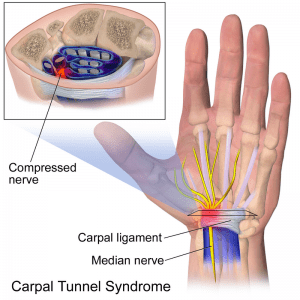In the intricate machinery of the human body, the delicate balance required for optimal function can sometimes be disrupted by conditions like Carpal Tunnel Syndrome (CTS). This common and often misunderstood disorder affects the hand and wrist, causing pain, numbness, and tingling.
Understanding the nuances of Carpal Tunnel Syndrome—from its anatomy and causes to its symptoms and treatment options—is essential for individuals grappling with hand discomfort and seeking effective solutions.
Anatomy of the Carpal Tunnel:
The carpal tunnel is a narrow passageway located on the palm side of the wrist. It is formed by the carpal bones on the bottom and sides and a strong band of connective tissue called the transverse carpal ligament on top. Within this confined space run tendons, controlling finger movement, and the median nerve, responsible for providing sensation to the thumb, index finger, middle finger, and part of the ring finger. When the median nerve becomes compressed or irritated, Carpal Tunnel Syndrome can develop.
Unmasking the Culprits: Causes of Carpal Tunnel Syndrome:
Carpal Tunnel Syndrome often results from a combination of factors that increase pressure on the median nerve or reduce the available space within the carpal tunnel. Common causes and contributing factors include:
- Repetitive Hand Movements: Jobs or activities that involve repetitive hand and wrist movements, such as typing, using vibrating tools, or assembly line work, can contribute to the development of CTS.
- Hand and Wrist Positioning: Prolonged or repetitive activities that involve flexing or extending the wrist, especially in awkward positions, may increase the risk of Carpal Tunnel Syndrome.
- Anatomical Factors: Certain individuals may have a smaller carpal tunnel by nature, making them more susceptible to nerve compression.
- Medical Conditions: Conditions such as rheumatoid arthritis, diabetes, and hypothyroidism have been associated with an increased risk of CTS.
- Pregnancy: Hormonal changes during pregnancy can lead to fluid retention, increasing pressure within the carpal tunnel and potentially causing symptoms of Carpal Tunnel Syndrome.
- Trauma or Injury: Fractures or trauma to the wrist may result in swelling or dislocation, putting pressure on the median nerve.
- Obesity: Excess body weight can contribute to inflammation and increased pressure within the carpal tunnel.
The Symphony of Symptoms: Recognizing Carpal Tunnel Syndrome:
The hallmark symptoms of Carpal Tunnel Syndrome typically manifest gradually and may initially be mild, progressing over time. Common symptoms include:
- Numbness and Tingling: Individuals with CTS often experience numbness, tingling, or a “pins and needles” sensation in the thumb, index finger, middle finger, and part of the ring finger. This may occur intermittently or persistently.
- Pain and Discomfort: Pain or aching in the hand or wrist, often radiating up the arm, is a common symptom of Carpal Tunnel Syndrome. The discomfort may be more pronounced during activities that involve use of the hand and wrist.
- Weakness: Reduced grip strength and a sense of weakness in the hand are common manifestations of CTS. Individuals may find it challenging to grasp small objects or perform tasks requiring fine motor skills.
- Nighttime Symptoms: Many people with Carpal Tunnel Syndrome experience an exacerbation of symptoms at night. Numbness and pain may wake individuals from sleep, and shaking or moving the affected hand may provide temporary relief.
- Thumb Weakness: In advanced cases, weakness or atrophy of the muscles at the base of the thumb may occur, affecting the ability to pinch or grasp objects.
The Diagnostic Canvas: Evaluating Carpal Tunnel Syndrome:
Diagnosing Carpal Tunnel Syndrome involves a comprehensive evaluation by a healthcare professional, often starting with a detailed medical history and physical examination. Common diagnostic approaches include:
- Tinel’s Sign: Tapping on the median nerve at the wrist can elicit tingling or electrical sensations in individuals with Carpal Tunnel Syndrome.
- Phalen’s Test: Holding the wrists in a flexed position for a minute may reproduce symptoms in those with CTS.
- Nerve Conduction Studies (NCS): NCS involves measuring the speed at which electrical impulses travel along the median nerve. Slower conduction may indicate nerve compression.
- Electromyography (EMG): EMG measures the electrical activity of muscles and can help identify nerve dysfunction.
- Imaging Studies: In some cases, imaging studies such as X-rays or ultrasound may be used to assess the structures within the wrist and rule out other potential causes of symptoms.
Accurate diagnosis is crucial for developing an appropriate treatment plan and preventing potential complications associated with untreated Carpal Tunnel Syndrome.
Navigating the Treatment Landscape: Managing Carpal Tunnel Syndrome:
The management of Carpal Tunnel Syndrome depends on the severity of symptoms and may involve a combination of conservative measures and, in some cases, surgical intervention. Common treatment approaches include:
- Wrist Splints: Wearing a wrist splint to keep the wrist in a neutral position can alleviate symptoms, especially at night.
- Activity Modification: Making adjustments to hand and wrist activities, taking breaks, and incorporating ergonomic tools can reduce strain on the median nerve.
- Nonsteroidal Anti-Inflammatory Drugs (NSAIDs): Medications such as ibuprofen or pregabalin 75 mg may help alleviate pain and reduce inflammation.
- Corticosteroid Injections: Injections of corticosteroids into the carpal tunnel can help reduce inflammation and provide relief from symptoms.
- Physical Therapy: Targeted exercises and stretches may be prescribed to improve strength, flexibility, and reduce pressure on the median nerve.
- Occupational Therapy: Occupational therapists can provide guidance on modifying activities and using adaptive tools to minimize strain on the hands and wrists.
- Surgery (Carpal Tunnel Release): In cases where conservative measures are not effective, or symptoms are severe, carpal tunnel release surgery may be recommended. This procedure involves cutting the transverse carpal ligament to relieve pressure on the median nerve.
The Journey Forward: Prognosis and Preventive Measures:
The prognosis for individuals with Carpal Tunnel Syndrome varies, with many experiencing significant improvement with conservative measures. Early intervention and adherence to recommended treatments contribute to positive outcomes.
Preventive measures and lifestyle modifications can also play a role in managing Carpal Tunnel Syndrome:
- Ergonomic Workspace: Ensuring that workstations are ergonomically designed can reduce strain on the hands and wrists.
- Regular Breaks: Taking breaks during repetitive tasks involving hand and wrist movements can prevent overuse and reduce the risk of CTS.
- Proper Hand Positioning: Maintaining a neutral wrist position during activities can minimize stress on the median nerve.
- Strengthening Exercises: Incorporating hand and wrist strengthening exercises into a regular routine can enhance overall hand health.
- Weight Management: Maintaining a healthy weight can reduce the risk of developing conditions associated with Carpal Tunnel Syndrome, such as obesity and metabolic disorders.
In conclusion, Carpal Tunnel Syndrome is a common condition that can significantly impact daily life. Understanding its causes, symptoms, and available treatment options empowers individuals to take proactive steps in managing and preventing the onset of symptoms. With a combination of conservative measures, medical interventions, and lifestyle modifications, individuals can navigate the path of hand discomfort and work towards improved hand health and overall well-being.






